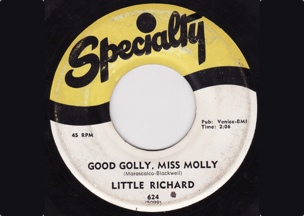I heard a story on NPR last week about a radio station in Canada that is experimenting with a new format called Quickhitz. For this format, the station is editing songs in order to reduce their duration. Their motto is “Now twice the music!”. Before you tell me what a horrible idea this is (and how bad it is for music in general), I’ll remind you that Quickhitz was developed by the same company that developed the Jack FM format in 2002, and this format has taken over slots on most metropolitan airwaves worldwide. (I would also like to point out that it can be successful and still be bad for music…)
The interesting bit in the interview came when the radio station’s spokesman pointed out that we expect a song to be 3 to 4 minutes long only because that is how much material fits on a 45 r.p.m. record – the format used when radio stations first began playing rock ‘n’ roll. While some data I found indicates that average song durations actually dropped after the introduction of the 45 (falling to less than the disc could hold and continuing to drop until 1960 when it began to grow to its current average length of 4 minutes), I do agree that years upon years of 3- to 4-minute pop tunes have conditioned most of us to think of that format as the standard. This happened in the same way that previous generations of musicians learned to arrange melodies into motets, fugues, and symphonies.
Whenever I think of format wars, I immediately think of point cloud deliverables. When clients request a drawing sheet set, I feel as though they are asking me to reduce my 3D Blu-ray to VHS so that they can watch it at home. Why do they do this? Institutional memory has conditioned us all to expect certain forms/formats in all sorts of disciplines, and we’ve relied upon drawing sheet sets or blueprints in some form for ages.
Of all of the self-described scanning “evangelists,” I know I may be the most willing to hand my clients that “VHS tape.” After all, it’s their money and it doesn’t matter how well I record an environment if they can’t access a copy of it. However, the skill required to read a complex drawing sheet set and understand the reality of that environment is quickly and steadily disappearing – that skill used to be held by the majority of our clients, and is now held by a minority. Because of this, the immersion and interactivity of 3D data such as meshes and point clouds may work in our favor.
The Quickhitz format is aimed squarely at younger demographics — the same demographics that prefer a tweet to a phone call, an email to a letter, and the interactivity of Spotify to that of radio. Look at those preferences and then think about who finds the reality capture devices that we are using to be appealing. The devices have a shorter collection time and are all digital. They create a deliverable that is completely interactive, a “real” deliverable that is immediately recognizable instead of one that requires the translation of nomenclature to mentally render.
You can deride this push toward new devices and deliverables as being driven by a lack of focus or an inability to concentrate on anything longer than a sound bite. You can also view it as the inevitable outcome of constant multi-tasking. Either way, there seem to be multiple pressures changing the format of information delivery on all fronts.
As a guy living in Nashville, I am all too aware of the mimicry when someone chases a hit release. But when I compare these new, successful media delivery formats and 3D-imaging deliverables, well, they both sound like hits to me.






